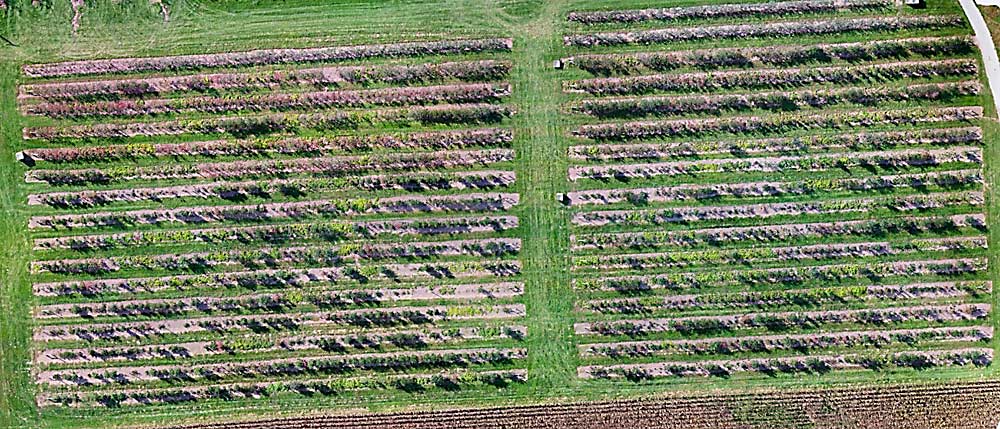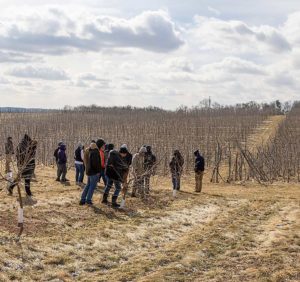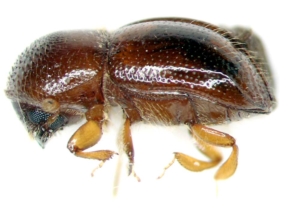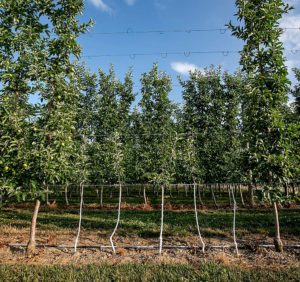
Researchers who believe the rapid apple decline reported in Eastern U.S. apple regions in recent years is a new phenomenon, rather than winter injury hitting highly stressed dwarf trees, are collecting clues to the mystery, including a virus found in the most susceptible young Malling 9 roots.
Penn State University tree fruit pathologist Kari Peter shared the latest findings, including what she has learned about the new virus she discovered in 2016, at the International Fruit Tree Association’s 65th annual conference in Hershey, Pennsylvania, in February.
Peter and other researchers call it rapid, or sudden, apple decline because the time period between observing symptoms and tree death is very short. Young trees will often have a full crop, then collapse suddenly mid-summer. It doesn’t hit every tree, but once trees start declining, they decline quickly.
Signs of RAD begin at the graft union, where tissues start to die. The necrosis proceeds up the tree, but it does not go down to the rootstock, which remains unaffected, she said.
RAD has mainly been found in Eastern states, with some reports in the Midwest and even a few in the Pacific Northwest, Peter said. Though they’re still trying to figure out the cause, or causes, researchers have ruled out fire blight. It doesn’t appear to be a replant problem, either. It could be a combination of tree stressors, including winter injury, drought, herbicide injury and wood-boring beetles.
Rob Crassweller, a recently retired Penn State professor and extension specialist, told IFTA that the trend of higher planting densities, coupled with rising temperatures, could be contributing to incidences of rapid apple decline. Tighter spacings limit root growth and deplete soil moisture, which adds to tree stress, he said.
Peter said cultivar doesn’t seem to be a factor in RAD incidence. The syndrome doesn’t affect semidwarf trees or older high-density plantings, either. RAD is concentrated in young, high-density plantings on Malling 9 rootstock and its clones.
“This is an M.9 problem,” Peter said. “Something has changed with M.9 root production. It seems to be more vulnerable than it should be. Folks who’ve been in the industry way longer than me say this is something unique. We’re trying to figure out what’s occurred to make the rootstock so vulnerable.”
In December 2016, they found a possible puzzle piece, a previously undescribed virus they called apple luteovirus 1, or ALV1. ALV1 is the first of the Luteovirus genus to be found in apple trees, Peter said.
Luteoviruses in woody plants can be transmitted by aphids or grafting. They exist only in the phloem cells of an infected plant and are known to kill phloem cells when the plant is stressed, she said.
ALV1 is hard to diagnose, but it seems to be more common in orchards on M.9 rootstocks planted within the last 10 years — the same orchards that are susceptible to RAD symptoms. ALV1 is very rare in older M.9 trees, she said.
“Is (ALV1) a recent introduction, or has it always been there but not causing any problems?” Peter asked. “We don’t know.”
When testing nursery stock, they’ve found ALV1 in small amounts in a few other rootstocks, but not with the consistency they’ve found in M.9 clones, she said.
At first, Peter wasn’t sure how strong the connection was between ALV1 and RAD, but the data she’s accumulated over the past few years makes her think the virus could be contributing to the syndrome. Trees with ALV1 more readily succumb to stressors that compromise the graft union, she said.
Though it’s not yet a “smoking gun,” the connection between ALV1 and RAD will continue to be investigated, Peter told the IFTA audience.
—by Matt Milkovich









Leave A Comment